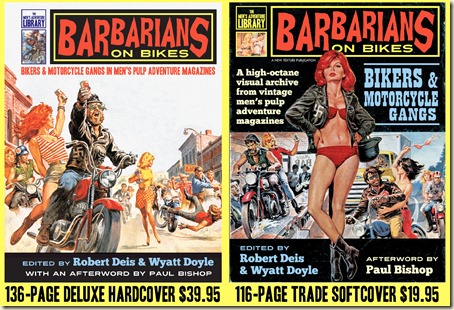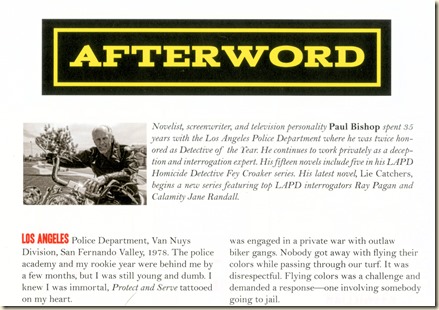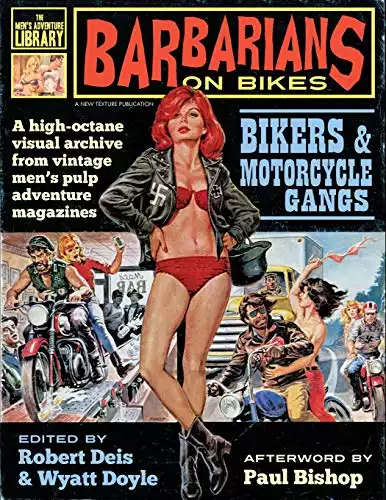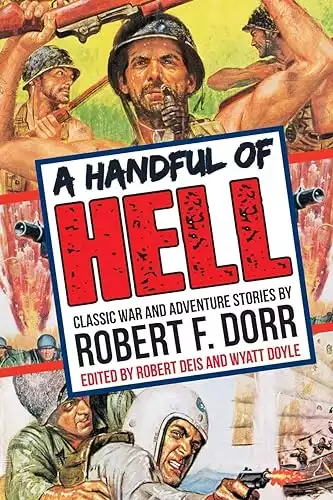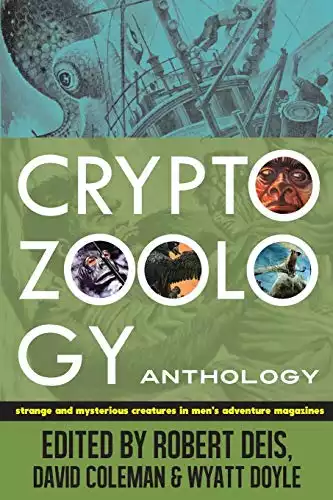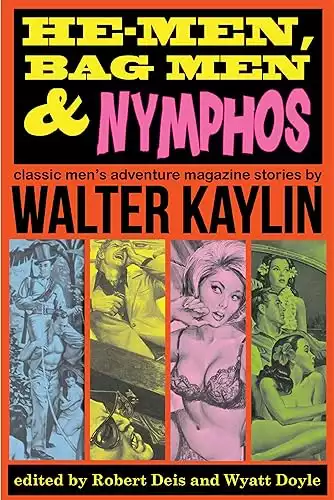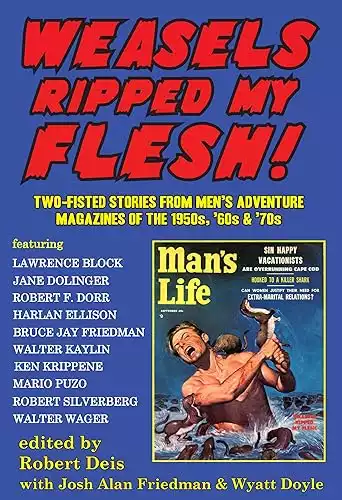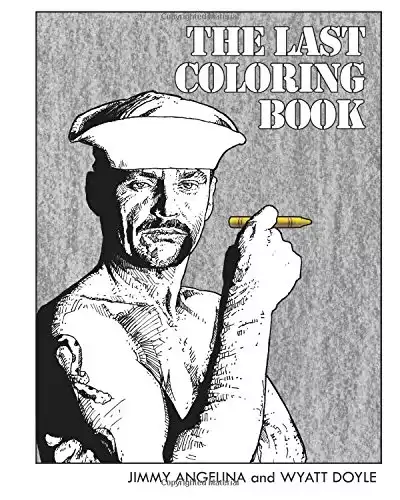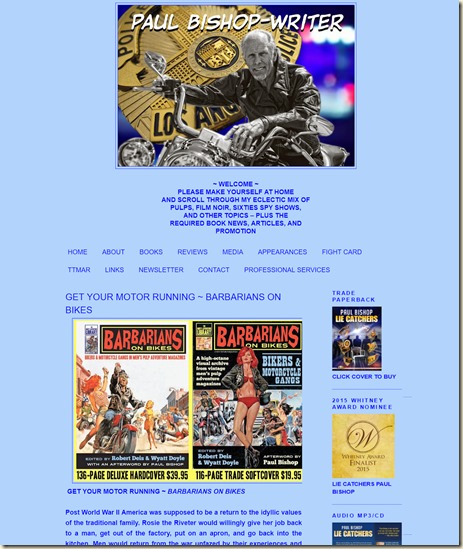
EDITOR’S NOTE: When Wyatt Doyle and I got the idea for an art book featuring bikers and motorcycle gangs, we ran it by our friend Paul Bishop. In addition to being a popular novelist and editor, Paul is a savvy independent publisher whose advice we highly value. We are big fans of his novels about LAPD Homicide Detective Fey Croaker, his recent genre-bending novel LIE CATCHERS and the manly “Fight Card” series of boxing-related novels he edited and published in recent years.
Paul not only liked our biker book idea, he also offered to write something for it based on his experience with motorcycle club members during his first career as a detective with the Los Angeles Police Department. Several months later, we published BARBARIANS ON BIKES, a visual archive of men’s pulp adventure magazine covers, interior illustrations and photographs depicting bikers and outlaw motorcycle gangs, complete with a special Afterword by Paul.
When it was released, Paul did an interview with us for his blog, where he writes about everything from crime, detective and men’s adventure novels to Sixties spy shows, film noir, old pulp and “new pulp.” For folks who read the MensPulpMags.com blog but may not yet know about Paul’s, I am reposting the entire interview and Paul’s introduction to it below, along with some 2-page scans from the book that are different from those he posted.
“GET YOUR MOTOR RUNNING”
Paul Bishop’s interview with Wyatt Doyle & Bob Deis
Post World War II America was supposed to be a return to the idyllic values of the traditional family. Rosie the Riveter would willingly give her job back to a man, get out of the factory, put on an apron, and go back into the kitchen.
Men would return from the war unfazed by their experiences and take up the responsibility of providing for their families without missing a beat.
If the American family was not restored to the pinnacle of its idealized form, how could we justify all that was sacrificed in fighting for our freedom and the freedom of our nation’s friends?
However, much of America wasn’t buying it. We had been to the gates of Hell and beyond. We were warriors, and supporters of warriors. We had discovered our dark sides where we were selfish, driven, ambitious, strategic and most importantly…killers.
To go to war—to win a war on the largest scale imaginable—we had to go dark, black even, become comfortable with the human wildness within us. And we did it—we won the war—only to come home and be expected to return to normal. But what was normal?
The American male had experienced first-hand the devastation, the killing, the hunger—the starvation even—and the torture. Our hearts knew the darkness and it called to us despite every desire to want the FATHER KNOWS BEST, LEAVE IT TO BEAVER, separate beds for Lucy and Ricky world being shoved down our throats.
The wounded American psyche was forcibly repressed. Everywhere we turned TV, Madison Avenue, the stress of keeping up with the Jones, the responsibility for too many decisions in a world without orders to follow, all of it added up to create a human pressure cooker.
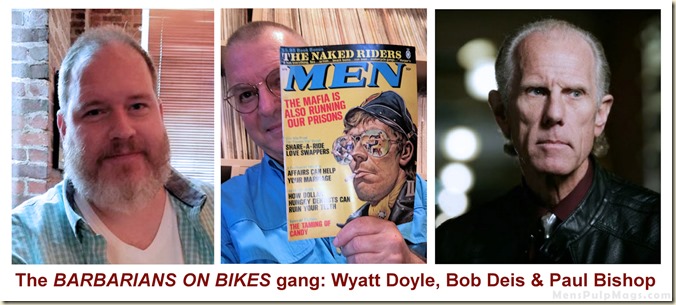 There had to be an outlet for our wildness, our darkness, our pent up adrenaline, a way to understand the horror we had been through.
There had to be an outlet for our wildness, our darkness, our pent up adrenaline, a way to understand the horror we had been through.
Enter the men’s adventure magazines…
Published from the late ’40s through the early ’70s, these slick-cover magazines catered to a male audience with lurid “true” tales of adventure, of “true” wartime daring, exotic travel, and attacks by wild animals of every ilk (e.g., “WEASELS RIPPED MY FLESH”).
Many covers, created by some of the most brilliant artists of the day, featured scenes of scantily clad, tiny-waisted, big breasted women in jeopardy being rescued by muscular male heroes toting big guns, spears, knives, and other phallic symbols.
There were also covers showing these same women about to be whipped, burned, fed to alligators, or sold into sexual slavery by leering Nazi officers, evil Nazi doctors, and horrendous Nazi torturers.
There was a need to confront such perversions—for men to know there was still a battle they could fight, still a damsel they could rescue (as they had rescued their wives, girlfriends, and families through the hell of battle).
They needed a way to be an unquestioned hero, to forge an explanation for the terrors and revulsions heaped upon them in war. To feel something—anything—again.
Slightly tawdry, hidden down the sides of dad’s armchair, stacked in his den or garage, the men’s adventure magazines (often misnomered as the sweats—a derogatory term not applied until the ‘80s by a new generation who had no understanding of the purpose) were a safe way to escape for men craving an existence beyond the world being forced upon them by societal expectations, disapproval, and repression.
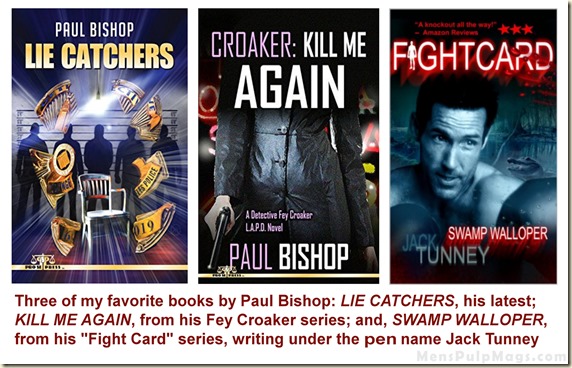 Starting in the early 1960s—before Hunter Thompson’s 1966 book Hell’s Angels made a splash and Grade B biker movies were common at drive-in theaters—men’s adventure magazines began publishing stories and covers featuring a new breed of home-grown bad guys: outlaw motorcycle gangs.
Starting in the early 1960s—before Hunter Thompson’s 1966 book Hell’s Angels made a splash and Grade B biker movies were common at drive-in theaters—men’s adventure magazines began publishing stories and covers featuring a new breed of home-grown bad guys: outlaw motorcycle gangs.
Men’s adventure magazines continued to feature outlaw bikers in stories, covers and interior artwork and photos through into the mid-1970s, when the MAM genre faded away.
The life of the outlaw biker provided two inherent, exploitable, viewpoints. The vicarious promise of unbridled freedom, of throwing away the shackles of repression in an orgy of roaring engines, lust, and brutality—or the chance to empathically take on this new evil and emerge victorious from a new war on American values.
They were also an amazingly colorful explosion of violence for the men’s adventure magazine cover artists—tired of Nazi torturers and running out of deadly attack animals (“CHEWED TO BITS BY GIANT TURTLES”)—to exploit.
While the stories within the pages of the men’s adventure magazines remain highly underrated—many writers who went on to become bestselling authors got their start in the men’s adventure magazines—the cover art and interior illustrations have become a collectible commodity.
Recognizing the continuing particular allure of those outlaw motorcycle gang covers and illustrations, men’s adventure magazine collector and guru Robert Deis and his publishing partner Wyatt Doyle recently added a new book, BARBARIANS ON BIKES, to their Men’s Adventure Library series.
Unlike their previous anthologies in that series, which collect men’s adventure magazine stories and the artwork accompanying them (WEASELS RIPPED MY FLESH!, HE-MEN, BAG MEN, AND NYMPHOS, CRYPTOZOOLOGY ANTHOLOGY and A HANDFUL OF HELL), BARBARIANS ON BIKES is all artwork and photos.
It’s a stunning, large format (8.5” x 11”), full-color visual archive of men’s adventure magazine covers, interior illustrations and photos featuring outlaw motorcycle gangs and other biker-related images.
I recently had the opportunity to chat with Deis and Doyle about the new collection (to which I was honored to add an afterword)…
PAUL BISHOP: After four successful Men’s Adventure Library books collecting some of the best short stories from the genre, what made you decide to do a collection featuring strictly covers and other artwork?
WYATT DOYLE: We pack our anthologies with supplemental artwork, but the focus there is on the writing. A second format, emphasizing the artwork, was a logical next step. BARBARIANS does include a brief introduction, providing a bit of history and context, and your afterword is a potent reality check at the finish. But for the most part, we simply wanted to unleash the wealth of killer art and wild headlines.
Like all our other Men’s Adventure Library releases, we hope it also serves as a lure, encouraging further expeditions into all facets of the magazines’ world—the artwork, the stories, the history, and the mags’ unacknowledged impact on popular culture.
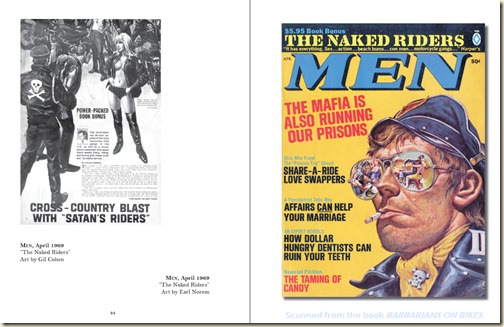 BOB DEIS: And, of course, the cover and interior artwork is terrific! It was done by some of the best illustrators of the era: artists like Mort Künstler, Charles Copeland, Norm Eastman, Bruce Minney, Basil Gogos, Samson Pollen, Gil Cohen, Al Rossi, John Duillo, Norman Saunders and Earl Norem.
BOB DEIS: And, of course, the cover and interior artwork is terrific! It was done by some of the best illustrators of the era: artists like Mort Künstler, Charles Copeland, Norm Eastman, Bruce Minney, Basil Gogos, Samson Pollen, Gil Cohen, Al Rossi, John Duillo, Norman Saunders and Earl Norem.
PAUL: What drew you to the theme of outlaw bikers and other motorcycle-related images?
BOB: Wyatt and I are both fans of biker movies from the ‘60s and ‘70s. The biker stories and artwork in men’s adventure magazines are as wild and crazy-cool as those movies. We realized that, along with biker movies, men’s adventure magazines had been important in creating and spreading the popular image of outlaw motorcycle gangs in the ’60s and ’70s, the “1 percenter” bikers.
As we dug deeper, we realized they had actually played a key role, just as they did in expanding awareness of Bigfoot, Sasquatch and other creatures from the realm of cryptozoology. [EDITOR’S NOTE: See our book the CRYPTOZOOLOGY ANTHOLOGY for more about that.]
WYATT: I can credit my dad (who rides) for early and prolonged exposure to biker movies, and I’ve found men’s adventure magazine fiction to be the one place where the presentation of outlaw biker culture mirrors the way it’s presented in biker B-movies. Neither is all that accurate when stacked against the real thing, but both the mags and the movies distort reality in similar ways.
The ping-pong of concepts and iconography between the two serves as a rough chart to the growth and expansion of outlaw biker mythology in popular culture. It was a mutually beneficial exploitation; they regularly ripped—and riffed—off each other. I believe our book is the first to point this out; it’s certainly the first to provide such a wealth of supporting evidence!
PAUL: Why do you feel it is important to preserve the images and stories from the men’s adventure magazines?
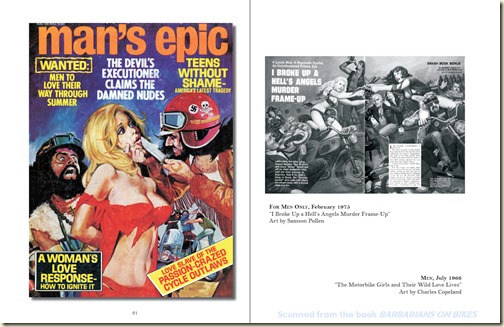 BOB: Well, it may sound odd, but in part, it’s related to what I studied in college at Ohio State University. My degree was in cultural anthropology, which involves the study of the customs, beliefs, mythologies and worldviews of people in different cultures. When I first started collecting and reading vintage men’s adventure magazines, I realized they were a huge and mostly overlooked source of information about mid-20th century American culture.
BOB: Well, it may sound odd, but in part, it’s related to what I studied in college at Ohio State University. My degree was in cultural anthropology, which involves the study of the customs, beliefs, mythologies and worldviews of people in different cultures. When I first started collecting and reading vintage men’s adventure magazines, I realized they were a huge and mostly overlooked source of information about mid-20th century American culture.
That’s the wonky part of me. The geeky part is that I just totally love men’s adventure magazine stories and artwork. Many of the fiction stories are as good as or better and grittier than those in the earlier pre-World War II pulp magazines.
The non-fiction, news-style articles and exposés are also interesting to read. They provide a whole different perspective on American history and culture and world events than you find in mainstream magazines from the ‘60s and ‘70s.
WYATT: A big part of our mission with the Men’s Adventure Library is to restore a wider awareness of the magazines and their place in pop culture history. They were an everyday part of the landscape for three decades, then vanished entirely.
Yet despite their long absence and relative obscurity today, their impact is recognizable and continues to be felt, decades after the last men’s adventure magazines left newsstands. We see men’s adventure magazines as an invisible hand that has shaped many enduring trends and fascinations, in entertainment of all stripes, and culturally, too.
Easy access to back issues and detailed histories of the mags’ upwardly mobile contemporaries – glossy slicks with big advertisers, like PLAYBOY and ESQUIRE – are readily available to any interested reader, and those periodicals are recognized as essential resources in understanding the era and the culture. Fair enough. But what about the working stiffs on the other side of the American Dream? The folks who gravitated to the slicks’ rougher cousins, embracing the mags’ unpretentious fists-and-cleavage escapism?
The popularity of these magazines marked one of the last gasps of the American working class as a reading class. So what were we reading, and how was it shaping (or reinforcing) our attitudes and ambitions? ESQUIRE’S slogan is “Man at His Best.” Documenting our culture at its best is important. But that’s a very narrow slice of America, in any era! The fantasies and diversions of working men in those years tell us much that our best do not.
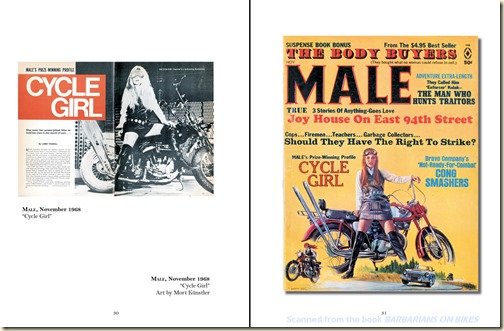 PAUL: What was your criteria in choosing the images and covers to include in Barbarians on Bikes?
PAUL: What was your criteria in choosing the images and covers to include in Barbarians on Bikes?
BOB: One was to try to show that many were done by the great artists I mentioned. My own secondary criteria was to include images from all three decades when the men’s adventure magazines were being published, to show that men’s adventure magazines were doing stories about bikers even before the biker movies became popular and show how the images of bikers evolved over time.
WYATT: Additionally, we recognized stills from numerous biker movies (both classic and obscure) had been repurposed as bogus news photos in the mags. We included a generous sampling of those, so cult film fans will enjoy playing “Name That Movie.” Other photo illustrations show evidence of occasionally comical doctoring in order to suit the over-the-top true story they accompany.
Take MALE’S bogus “CYCLE GIRL” profile from 1968. Its biker babe photo illustration is actually a publicity shot from a Brigitte Bardot television special – it was even a popular pin-up poster at the time! Someone in the MALE art department simply painted on a pair of racing goggles in a half-hearted attempt to disguise the still very recognizable image. That kind of gonzo resourcefulness is a big part of the magazines’ appeal.
PAUL: Tell us about the history of the outlaw biker covers and the artists who painted them?
BOB: From their very start back in the 1950s, men’s adventure magazines included stories, artwork, and photos featuring motorcycle riders. But there weren’t many, and they featured adventurers and soldiers, not Hells-Angels-style outlaw bikers. However, there is an interesting early story about the Hells Angels in the December 1957 issue of the men’s adventure magazine ACE, about a bloody melee involving over a thousand outlaw bikers at the place called Angel’s Camp in Calaveras County, California. That story is illustrated with a photo.
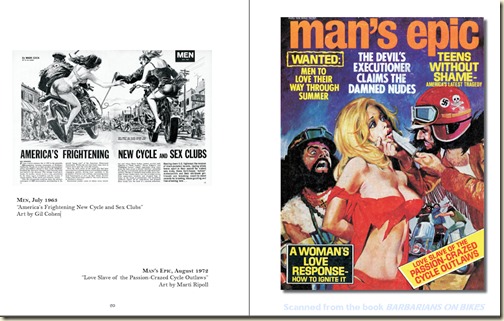 The first outlaw biker covers and interior illustrations started showing up in the early 1960s, and the bikers often looked more like Teddy Boys on Hondas rather than Angels on Harley Hogs. By 1963, the artwork began to tilt to what would become the iconic image of outlaw bikers.
The first outlaw biker covers and interior illustrations started showing up in the early 1960s, and the bikers often looked more like Teddy Boys on Hondas rather than Angels on Harley Hogs. By 1963, the artwork began to tilt to what would become the iconic image of outlaw bikers.
Look no further than the story in MEN, July 1963, “AMERICA’S FRIGHTENING NEW CYCLE AND SEX CLUBS.” The illustration was done by Gil Cohen, who did hundreds of men’s adventure mag illustrations and many paperback covers, including classic covers for the Mack Bolan/Executioner series. Cohen’s illustration shows outlaw bikers, with scantily clad Mamas on their bikes behind them, terrorizing a town.
That was two years before the release of the famous 1965 report on biker gangs by California Attorney General Thomas C. Lynch, which grabbed headlines nationwide and led to the biker hysteria of the mid-1960s (and subsequent rise of the biker genre in exploitation movies).
From that point to the mid-1970s, outlaw biker stories, covers, and interior artwork were a common feature of men’s adventure magazines. That artwork was being done by almost all of the best illustrators who worked for them, including Cohen, Künstler, Copeland, Eastman, Minney, Gogos, Pollen, Duillo, Norem, Saunders, and most of the other top professionals who created the bulk of the artwork for men’s pulp adventure magazines as well as for thousands of mid-20th century adventure, crime, and Western paperbacks.
In general, most of the biker artwork they did depicted vicious, violent outlaw bikers partying and pillaging their way through the world, though some involved good guys on motorcycles battling Nazis, Commies or outlaw bikers.
In the ‘60s and ‘70s, hundreds of issues of men’s adventure magazines featured biker stories and illustrations. So many, that bikers actually eclipsed Nazis as the most common bad guys featured in men’s adventure magazines.
From about 1970 to 1976, the final years of the MAM genre, cover paintings and interior artwork were increasingly replaced by photos. But, as we show, there was still some outstanding biker artwork in men’s adventure mags published in the mid-1970s. By then, biker covers were more common than even Nazi covers on the low-budget “sweat mags,” and some of the mid-tier Magazine Management mags still had very cool biker art by their old stalwarts, like Samson Pollen and Bruce Minney.
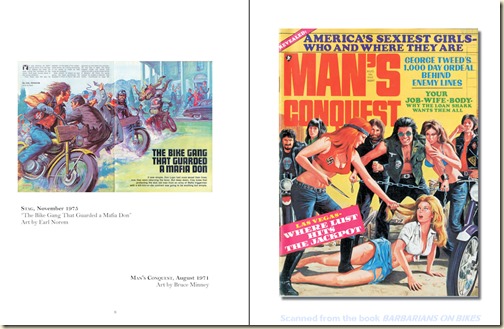 PAUL: Do you have a favorite cover in the collection or one cover you would say is representative of the genre?
PAUL: Do you have a favorite cover in the collection or one cover you would say is representative of the genre?
BOB: Actually, I think the interior illustrations shown in our book are often even cooler than the covers, even though most were either black-and-white or two-color duotone paintings. But among the covers, I’d have to say the Earl Norem painting we used for the paperback edition of our book is probably my fave, followed closely by the Norem painting we used on the hardcover edition. And, their scenes of bikers running amok are pretty representative of what many of the biker stories and artwork are like.
WYATT: Bob makes a good point about not overlooking the interiors. A cover painting needs to have immediate impact and appeal, something the viewer can process in an instant. That’s cover artwork’s job, to make you pick up the magazine. But once inside, the editors felt freer to get wilder and expand their horizons—literally!
There’s just something about the widescreen frame of a two-page spread that lent itself particularly well to this subject, and inspired artists to go all-out. It’s impossible to pick a favorite, but I really go for the inventive compositions of Earl Norem (to whom we dedicated the book), and the comin’-at-ya action of Samson Pollen.
Those artists in particular brought something fresh and exciting to every piece. They had a real facility for scenes of biker mayhem that put the reader square in the middle of every fight, race, and escape. So if I have to choose favorites, they’d be Norem’s “CYCLE LONERS WHO BEAT TENNESSEE’S OUTLAW ANGELS,” probably the most action-packed piece in the book—you can practically hear the crunch of destruction, and Pollen’s “CYCLE NYMPH,” luxurious cheesecake and cycle action. Pollen’s mastery of the widescreen frame is really something.
PAUL: Are you considering a future collection of the outlaw biker stories that accompanied the covers displayed in BARBARIANS ON BIKES?
BOB: Yes, it’s already in the planning stages. It will probably be among the first examples of another new type of book we’re adding to the Men’s Adventure Library series: a journal format that will serve as a sort of hybrid of our story anthologies and our art-focused books. We’ll debut the first books in that format next year.
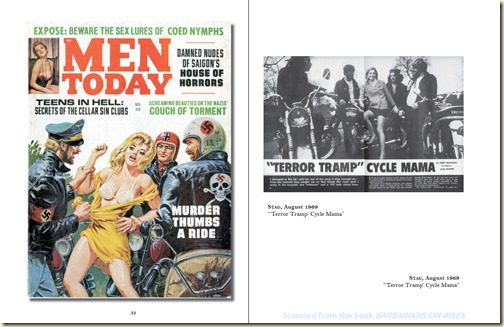 PAUL: What are the extras included in the deluxe hardcover edition of BARBARIANS?
PAUL: What are the extras included in the deluxe hardcover edition of BARBARIANS?
WYATT: It was important that we deliver quality reproduction to satisfy the high standards of serious collectors, but connecting with new fans is a priority, too. So for the merely curious, there’s an affordable softcover; for the serious collector, there’s an expanded, deluxe hardcover edition.
The deluxe hardcover uses archival paper and employs more expensive printing and binding. It includes 20 extra pages of additional images, and uses an alternate layout, spotlighting instances where artwork and stories were subsequently repurposed or reprinted, whether in a later issue, or in a different magazine from the same publisher.
The softcover is a great introduction and an ideal overview for the casual fan. But pulp scholars, collectors, and those who already know how great this stuff is will find more to sink their teeth into with the deluxe hardcover.
PAUL: The MensPulpMags.com Men’s Adventure Magazines blog is becoming more and more comprehensive. How did you come to start the blog and website, and how much effort does it take to maintain it?
BOB: Well, in my own mind, it’s still far from comprehensive, but I plan to keep pecking away at it and making it more so in the years ahead. I started the blog back in 2009, about a year after I became an obsessive collector of men’s adventure magazines. I looked around the internet and discovered that there weren’t any sites specifically dedicated to men’s adventure mags at the time. Earlier in my life, I had done quite a bit of writing for magazines and by 2009 blogging was starting to become bigger and easier to do, so I decided to start the MensPulpMags.com blog.
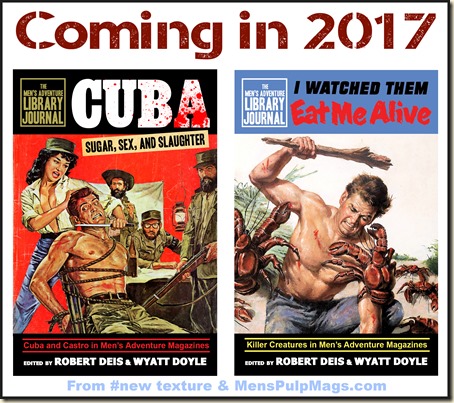 In the beginning, I did a post or two every week, but over the years, I began to focus more on our book projects and on posting in the Men’s Adventure Magazines Facebook Group I created. So, the frequency of my posts on MensPulpMags.com has declined. And this past year almost all of my free time was eaten up by an intense day-job project I agreed to take on to make some extra bucks. So, it wasn’t until recently that I started posting again.
In the beginning, I did a post or two every week, but over the years, I began to focus more on our book projects and on posting in the Men’s Adventure Magazines Facebook Group I created. So, the frequency of my posts on MensPulpMags.com has declined. And this past year almost all of my free time was eaten up by an intense day-job project I agreed to take on to make some extra bucks. So, it wasn’t until recently that I started posting again.
Anyway, nowadays, the era of the sequential-post style blog seems to be waning. I am starting to rethink how to reorganize the site and add to it to make it fit the idea of something that is more comprehensive. For example, I’d like to create a series of anchor pages providing overviews of various men’s adventure magazines and artists. So, I’m not sure how much time that will take in the months ahead.
I think doing frequent posts in my MAM Facebook group has kind of taken the place of frequent posting on MensPulpMags.com. I do posts there daily. And, there are now over 1,700 members in the group from all over the world who post things and comment. It has become a great place to share images and information with men’s adventure mag fans, and it’s quicker and easier to do Facebook posts.
PAUL: What can we expect next from New Texture both in the field of men’s adventure magazines and in other areas?
BOB: We’re not quite ready to announce all the details yet, but next year will be our biggest year yet in terms of the number of books we’ll be adding to the Men’s Adventure Library. We plan to launch the journal series I mentioned, as well as a collection of men’s adventure magazine stories written by the great Robert Silverberg.
We plan to do some more themed, large-format visual archive art books along the lines of BARBARIANS ON BIKES. Two we’re working on involve major celebrities in the realm of men’s adventure magazines, who recently gave us permission to do books that feature them.
WYATT: The emphasis at New Texture is on sideways autobiography and secret history, and working with Bob on Men’s Adventure Library releases always means plenty of both. Keep up with New Texture’s book and music releases at NewTexture.com.
— BOB AND WYATT SAY “THANKS AGAIN, PAUL! YOU ROCK, AMIGO!” —
* * * * * * * * * *
Comments? Questions? Corrections? Post them on the Men’s Adventure Magazines Facebook Group.
Related & recommended reading…


